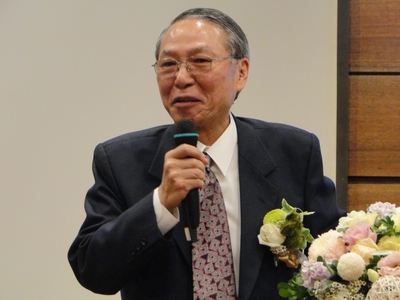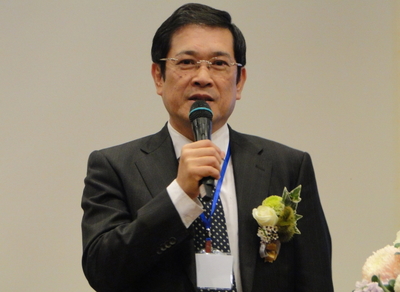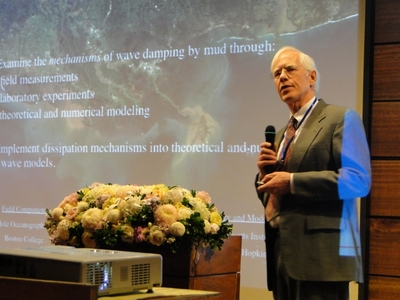NCKU Tainan Hydraulics Laboratory Celebrates 60th Anniversary



Tainan, Taiwan, December 10th, 2010
Tainan Hydraulics Laboratory of National Cheng Kung University (NCKU), Tainan, Taiwan, which started with a few teachers and students and gradually grown into the most advanced hydraulics laboratory in the world with the support of the university and the government, has celebrated its 60th Anniversary on December 10th with opening ceremony, special symposium and banquet, where teachers, students, officials, laboratory members, and internationally renowned hydraulic and ocean engineering experts have gathered together to celebrate this special day.
The 60th Anniversary of Tainan Hydraulics Laboratory Opening Ceremony and Seminar began with an opening ceremony, where NCKU Senior Executive Vice-President and also a professor from the NCKU Department of Hydraulic and Ocean Engineering Hwung-Hweng Hwung and Chief Wei-Fu Yang of Water Resources Agency, Ministry of Economic Affairs, delivered their opening remarks, and Prof. Robert A. Dalrymple from Johns Hopkins University, U.S., Prof. Hocine Oumeraci from Technische Universität Braunschweig, Germany, Prof. Masahiko Isobe from The University Tokyo, Japan, and Prof. Yoshimi Goda from Yokohama National University, Japan, brought their blessings delivered keynote speeches.
NCKU Senior Executive Vice-President Hwung-Hweng Hwung, the Director of Tainan Hydraulics Laboratory, said, “Looking back to the 60 years of development, I can only reveal my most sincere gratitude. Because of the confidence and trust the previous Presidents and the current President Michael Ming-Chiao Lai have in us, Tainan Hydraulics Laboratory can grow stronger everyday. Established in 1950, under the support of the Ministry of Economic Affairs and National Cheng Kung University, Tainan Hydraulics Laboratory began with only a few teachers and students, then we began accepting research projects and recruiting more members, accumulating to more than 130 today, as well as professors, about 50 people today, thus solidifying the capacity of the Laboratory on large-scale hydraulic and ocean research.”
Chief Wei-Fu Yang of Water Resources Agency, the Ministry of Economic Affairs, revealed in his opening remark, “The Tainan Hydraulics Laboratory, established under the joint efforts of Water Resources Agency and National Cheng Kung University, is celebrating its 60th Anniversary. In the past 60 years, Tainan Hydraulics Laboratory has acted as a professional research unit between Water Resources Agency and NCKU, continuing to conduct various surveys, experiments and analysis of hydraulics and ocean engineering for the national economic construction plan. Relying on its own efforts, Tainan Hydraulics Laboratory has become one of the world-class hydraulic and ocean engineering professional research units, with a strong impact on the hydraulic and ocean engineering experimental research field in Taiwan.”
As Prof. Robert A. Dalrymple from Johns Hopkins University, U.S., discussed some of the MURI efforts underway at Johns Hopkins University in the Coastal Engineering Laboratory in his keynote speech of “Fluid-Mud Interactions: The JHU Experience”, he stated, “A piston-type wave maker is used to generate waves in a wave tank that measures 18.3m long, 2.5m wide and 1.7m deep. The tank bottom has a 10m long recessed section containing a layer of mud, which is commercially available kaolinite clay mixed with water. When completely settled, the mud layer is approximately 8cm think with a density of approximately 1.5g/ml.”
He further explained, “Ensuring consistent mud conditions in the tank is critical to the validity of the experiments. If allowed to settle for too long, the mud becomes consolidated and does not interact significantly with the surface waves. If the mud layer is too mixed into the water column and does not have a significantly different density than the overlying water then it does not behave as a distinct layer. To achieve the desired properties consistently, the mud is mixed manually using a rake to stir up the clay from the bottom of the tank and create a well-mixed suspension throughout the tank.”
Prof. Robert A. Dalrymple also mentioned, “The experiments have proved that water groups have no significant affect on damping and damping is dependant on mud mobilization.”
Tainan Hydraulics Laboratory of National Cheng Kung University (NCKU), Tainan, Taiwan, which started with a few teachers and students and gradually grown into the most advanced hydraulics laboratory in the world with the support of the university and the government, has celebrated its 60th Anniversary on December 10th with opening ceremony, special symposium and banquet, where teachers, students, officials, laboratory members, and internationally renowned hydraulic and ocean engineering experts have gathered together to celebrate this special day.
The 60th Anniversary of Tainan Hydraulics Laboratory Opening Ceremony and Seminar began with an opening ceremony, where NCKU Senior Executive Vice-President and also a professor from the NCKU Department of Hydraulic and Ocean Engineering Hwung-Hweng Hwung and Chief Wei-Fu Yang of Water Resources Agency, Ministry of Economic Affairs, delivered their opening remarks, and Prof. Robert A. Dalrymple from Johns Hopkins University, U.S., Prof. Hocine Oumeraci from Technische Universität Braunschweig, Germany, Prof. Masahiko Isobe from The University Tokyo, Japan, and Prof. Yoshimi Goda from Yokohama National University, Japan, brought their blessings delivered keynote speeches.
NCKU Senior Executive Vice-President Hwung-Hweng Hwung, the Director of Tainan Hydraulics Laboratory, said, “Looking back to the 60 years of development, I can only reveal my most sincere gratitude. Because of the confidence and trust the previous Presidents and the current President Michael Ming-Chiao Lai have in us, Tainan Hydraulics Laboratory can grow stronger everyday. Established in 1950, under the support of the Ministry of Economic Affairs and National Cheng Kung University, Tainan Hydraulics Laboratory began with only a few teachers and students, then we began accepting research projects and recruiting more members, accumulating to more than 130 today, as well as professors, about 50 people today, thus solidifying the capacity of the Laboratory on large-scale hydraulic and ocean research.”
Chief Wei-Fu Yang of Water Resources Agency, the Ministry of Economic Affairs, revealed in his opening remark, “The Tainan Hydraulics Laboratory, established under the joint efforts of Water Resources Agency and National Cheng Kung University, is celebrating its 60th Anniversary. In the past 60 years, Tainan Hydraulics Laboratory has acted as a professional research unit between Water Resources Agency and NCKU, continuing to conduct various surveys, experiments and analysis of hydraulics and ocean engineering for the national economic construction plan. Relying on its own efforts, Tainan Hydraulics Laboratory has become one of the world-class hydraulic and ocean engineering professional research units, with a strong impact on the hydraulic and ocean engineering experimental research field in Taiwan.”
As Prof. Robert A. Dalrymple from Johns Hopkins University, U.S., discussed some of the MURI efforts underway at Johns Hopkins University in the Coastal Engineering Laboratory in his keynote speech of “Fluid-Mud Interactions: The JHU Experience”, he stated, “A piston-type wave maker is used to generate waves in a wave tank that measures 18.3m long, 2.5m wide and 1.7m deep. The tank bottom has a 10m long recessed section containing a layer of mud, which is commercially available kaolinite clay mixed with water. When completely settled, the mud layer is approximately 8cm think with a density of approximately 1.5g/ml.”
He further explained, “Ensuring consistent mud conditions in the tank is critical to the validity of the experiments. If allowed to settle for too long, the mud becomes consolidated and does not interact significantly with the surface waves. If the mud layer is too mixed into the water column and does not have a significantly different density than the overlying water then it does not behave as a distinct layer. To achieve the desired properties consistently, the mud is mixed manually using a rake to stir up the clay from the bottom of the tank and create a well-mixed suspension throughout the tank.”
Prof. Robert A. Dalrymple also mentioned, “The experiments have proved that water groups have no significant affect on damping and damping is dependant on mud mobilization.”
Provider:
新聞中心
Date:
99-12-10



